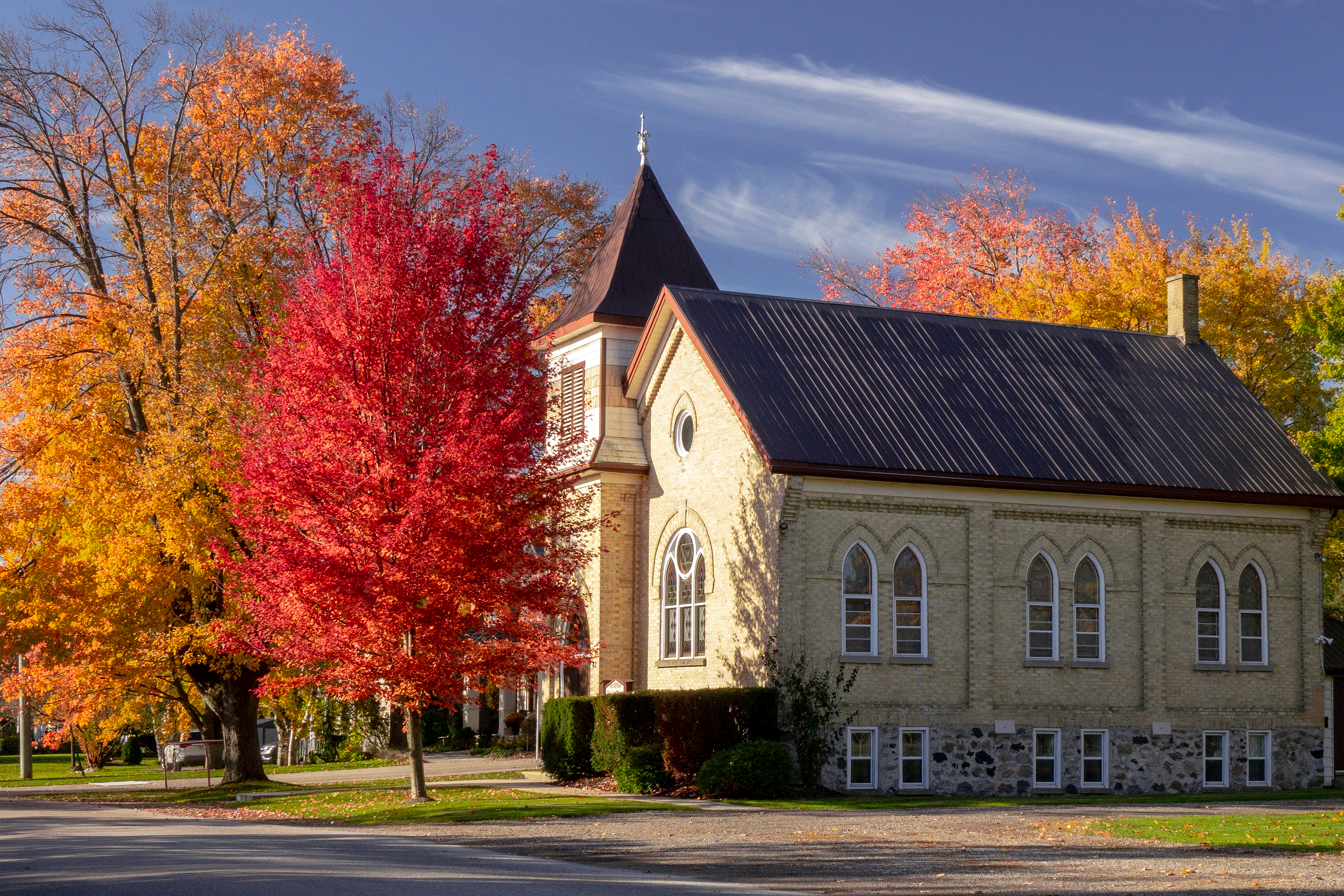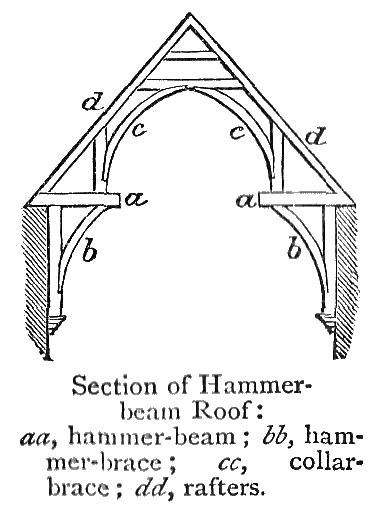|
George Street United Church
George Street United Church is a defunct church that was built in 1873 and was the oldest extant Methodist church building in St. John’s, Newfoundland and Labrador. Designed by Elijah Hoole, it was an example of a modified Gothic Revival church. In August 2023, church leadership announced that the congregation had disbanded in June due to financial difficulties. Plans are currently underway for a final service to mark the official closure of the church in October 2023. On February 11, 1862, the Reverend Edmund Botterell, the Hon. J.J. Rogerson and the Hon. Captain Edward White were appointed to a committee by the St. John's District of the Methodist Church to select a site for a new church and Sunday school in what was then the west end of St. John’s. The laying of the cornerstone of the George Street Methodist Church occurred ten years later. George Street was the second Methodist congregation in St. John's, the first being Gower Street. The church building survived the Great ... [...More Info...] [...Related Items...] OR: [Wikipedia] [Google] [Baidu] |
Methodist
Methodism, also called the Methodist movement, is a group of historically related denominations of Protestant Christianity whose origins, doctrine and practice derive from the life and teachings of John Wesley. George Whitefield and John's brother Charles Wesley were also significant early leaders in the movement. They were named ''Methodists'' for "the methodical way in which they carried out their Christian faith". Methodism originated as a revival movement within the 18th-century Church of England and became a separate denomination after Wesley's death. The movement spread throughout the British Empire, the United States, and beyond because of vigorous missionary work, today claiming approximately 80 million adherents worldwide. Wesleyan theology, which is upheld by the Methodist churches, focuses on sanctification and the transforming effect of faith on the character of a Christian. Distinguishing doctrines include the new birth, assurance, imparted righteousness ... [...More Info...] [...Related Items...] OR: [Wikipedia] [Google] [Baidu] |
Elijah Hoole (architect)
Elijah Hoole (1837 – 27 March 1912) was an English architect of Methodist churches, settlement halls and social housing. In relation to the social housing, he worked closely with the social reformer Octavia Hill for over 40 years. Early life Hoole was born in London in 1837 to Elijah Hoole, a Wesleyan Methodist missionary, and his wife, Elizabeth, the third daughter of the lock and safe manufacturer, Charles Chubb. Career Hoole was a pupil of James Simpson (not to be confused with James Simpson (engineer)) in 1854, and was subsequently his assistant until he set up his own practice in 1863. Hoole had a long working relationship with Octavia Hill: he was her "favourite" architect and worked for Hill for 40 years. Hoole employed a Ruskinian style and approach to Arts and Crafts design. In similar vein, he designed both the first university settlement, Toynbee Hall, and the only Methodist settlement, Bermondsey Settlement. He also designed Methodist churches in England ... [...More Info...] [...Related Items...] OR: [Wikipedia] [Google] [Baidu] |
Gothic Revival
Gothic Revival (also referred to as Victorian Gothic, neo-Gothic, or Gothick) is an architectural movement that began in the late 1740s in England. The movement gained momentum and expanded in the first half of the 19th century, as increasingly serious and learned admirers of the neo-Gothic styles sought to revive medieval Gothic architecture, intending to complement or even supersede the neoclassical styles prevalent at the time. Gothic Revival draws upon features of medieval examples, including decorative patterns, finials, lancet windows, and hood moulds. By the middle of the 19th century, Gothic had become the preeminent architectural style in the Western world, only to fall out of fashion in the 1880s and early 1890s. The Gothic Revival movement's roots are intertwined with philosophical movements associated with Catholicism and a re-awakening of high church or Anglo-Catholic belief concerned by the growth of religious nonconformism. Ultimately, the "Anglo-Catholicism" t ... [...More Info...] [...Related Items...] OR: [Wikipedia] [Google] [Baidu] |
Methodist Church (Canada)
The Methodist Church was the major Methodist denomination in Canada from its founding in 1884 until it merged with two other denominations to form the United Church of Canada in 1925. The Methodist Church was itself formed from the merger of four smaller Methodist denominations with ties to British and US Methodist denominations. History Laurence Coughlan was a lay preacher of the British Methodist movement. He arrived in Newfoundland in 1766 and began working among Protestant English and Irish settlers. In 1779 William Black, born in England but raised in Nova Scotia was converted to Methodism and commenced evangelizing in the Maritimes, his work falling under the supervision of the British Wesleyan Methodist Church in 1800. In 1855 this body formed the Wesleyan Methodist Conference of Eastern British America. [...More Info...] [...Related Items...] OR: [Wikipedia] [Google] [Baidu] |
Great Fire Of 1892
The Great Fire of 8 July 1892 in St. John's, Newfoundland and Labrador is remembered as the worst disaster ever to befall that city. Previous "Great Fires" had occurred in St. John's, during 1819 and 1846. Timeline At approximately 4:45 in the afternoon of July 8, 1892, a dropped pipe in Timothy O'Brien's stable, atop Carter's Hill on Freshwater Road, began what would become the worst fire in the history of St. John's. Initially, the fire did not cause any widespread panic; however, a series of catastrophic coincidences caused the fire to spread and devour virtually all of the east end of the city, including much of its major commercial area, before being extinguished. Rev. Moses Harvey witnessed the initial stages of the fire, and remarked to his friend that it "was a bad day for a fire." A high wind from the northwest was blowing, hurling the sparks far and wide on the roofs of the clusters of wooden houses. For a month previous, hardly any rain had fallen, and the shingled ... [...More Info...] [...Related Items...] OR: [Wikipedia] [Google] [Baidu] |
United Church Of Canada
The United Church of Canada (french: link=no, Église unie du Canada) is a mainline Protestant denomination that is the largest Protestant Christian denomination in Canada and the second largest Canadian Christian denomination after the Catholic Church in Canada. The United Church was founded in 1925 as a merger of four Protestant denominations with a total combined membership of about 600,000 members: the Methodist Church, Canada, the Congregational Union of Ontario and Quebec, two-thirds of the congregations of the Presbyterian Church in Canada, and the Association of Local Union Churches, a movement predominantly of the Canadian Prairie provinces. The Canadian Conference of the Evangelical United Brethren Church joined the United Church of Canada on January 1, 1968. Membership peaked in 1964 at 1.1 million and has declined since that time. From 1991 to 2001, the number of people claiming an affiliation with the United Church decreased by 8%, the third largest decrease in ... [...More Info...] [...Related Items...] OR: [Wikipedia] [Google] [Baidu] |
Lancet Window
A lancet window is a tall, narrow window with a pointed arch at its top. It acquired the "lancet" name from its resemblance to a lance. Instances of this architectural element are typical of Gothic church edifices of the earliest period. Lancet windows may occur singly, or paired under a single moulding, or grouped in an odd number with the tallest window at the centre. The lancet window first appeared in the early French Gothic period (c. 1140–1200), and later in the English period of Gothic architecture (1200–1275). So common was the lancet window feature that this era is sometimes known as the "Lancet Period". Retrieved 24 October 2006 The term ''lancet window'' is properly applied to windows of austere form, without |
Hammerbeam
A hammerbeam roof is a decorative, open timber roof truss typical of English Gothic architecture and has been called "...the most spectacular endeavour of the English Medieval carpenter". They are traditionally timber framed, using short beams projecting from the wall on which the rafters land, essentially a tie beam which has the middle cut out. These short beams are called hammer-beams and give this truss its name. A hammerbeam roof can have a single, double or false hammerbeam truss. Design A hammer-beam is a form of timber roof truss, allowing a hammerbeam roof to span greater than the length of any individual piece of timber. In place of a normal tie beam spanning the entire width of the roof, short beams – the hammer beams – are supported by curved braces from the wall, and hammer posts or arch-braces are built on top to support the rafters and typically a collar beam. The hammerbeam truss exerts considerable thrust on the walls or posts that support it. Hamm ... [...More Info...] [...Related Items...] OR: [Wikipedia] [Google] [Baidu] |
Cultural Heritage
Cultural heritage is the heritage of tangible and intangible heritage assets of a group or society that is inherited from past generations. Not all heritages of past generations are "heritage"; rather, heritage is a product of selection by society. Cultural heritage includes cultural property, tangible culture (such as buildings, monuments, landscapes, books, works of art, and artifacts), intangible heritage, intangible culture (such as folklore, traditions, language, and knowledge), and natural heritage (including culturally significant landscapes, and biodiversity).Ann Marie Sullivan, Cultural Heritage & New Media: A Future for the Past, 15 J. MARSHALL REV. INTELL. PROP. L. 604 (2016) https://repository.jmls.edu/cgi/viewcontent.cgi?article=1392&context=ripl The term is often used in connection with issues relating to the protection of Indigenous intellectual property. The deliberate act of keeping cultural heritage from the present for the future is known as Conservation (cul ... [...More Info...] [...Related Items...] OR: [Wikipedia] [Google] [Baidu] |
United Church Of Canada Churches In Newfoundland And Labrador
United may refer to: Places * United, Pennsylvania, an unincorporated community * United, West Virginia, an unincorporated community Arts and entertainment Films * ''United'' (2003 film), a Norwegian film * ''United'' (2011 film), a BBC Two film Literature * ''United!'' (novel), a 1973 children's novel by Michael Hardcastle Music * United (band), Japanese thrash metal band formed in 1981 Albums * ''United'' (Commodores album), 1986 * ''United'' (Dream Evil album), 2006 * ''United'' (Marvin Gaye and Tammi Terrell album), 1967 * ''United'' (Marian Gold album), 1996 * ''United'' (Phoenix album), 2000 * ''United'' (Woody Shaw album), 1981 Songs * "United" (Judas Priest song), 1980 * "United" (Prince Ital Joe and Marky Mark song), 1994 * "United" (Robbie Williams song), 2000 * "United", a song by Danish duo Nik & Jay featuring Lisa Rowe Television * ''United'' (TV series), a 1990 BBC Two documentary series * ''United!'', a soap opera that aired on BBC One from 1965-19 ... [...More Info...] [...Related Items...] OR: [Wikipedia] [Google] [Baidu] |
Christian Organizations Disestablished In The 2020s
Christians () are people who follow or adhere to Christianity, a monotheistic Abrahamic religion based on the life and teachings of Jesus Christ. The words ''Christ'' and ''Christian'' derive from the Koine Greek title ''Christós'' (Χριστός), a translation of the Biblical Hebrew term ''mashiach'' (מָשִׁיחַ) (usually rendered as ''messiah'' in English). While there are diverse interpretations of Christianity which sometimes conflict, they are united in believing that Jesus has a unique significance. The term ''Christian'' used as an adjective is descriptive of anything associated with Christianity or Christian churches, or in a proverbial sense "all that is noble, and good, and Christ-like." It does not have a meaning of 'of Christ' or 'related or pertaining to Christ'. According to a 2011 Pew Research Center survey, there were 2.2 billion Christians around the world in 2010, up from about 600 million in 1910. Today, about 37% of all Christians live in the Ameri ... [...More Info...] [...Related Items...] OR: [Wikipedia] [Google] [Baidu] |
.jpg)






